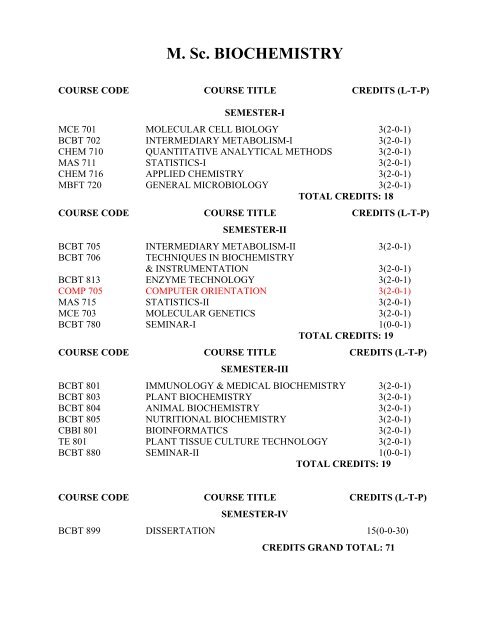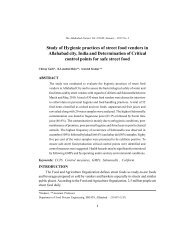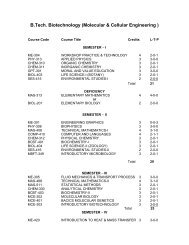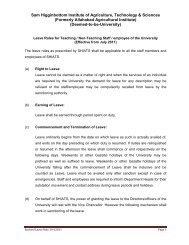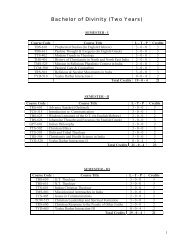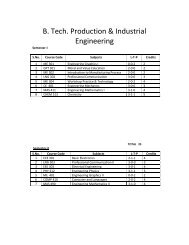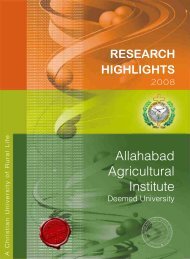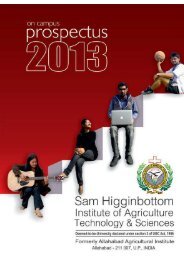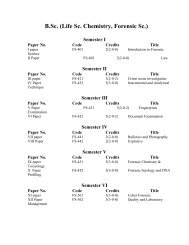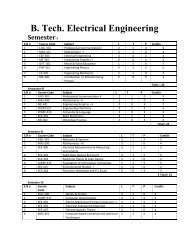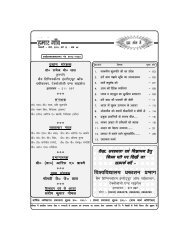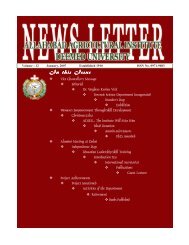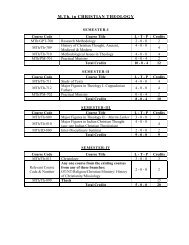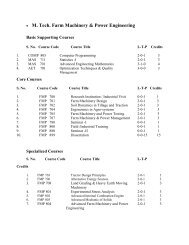M. Sc. BIOCHEMISTRY - Shiats.edu.in
M. Sc. BIOCHEMISTRY - Shiats.edu.in
M. Sc. BIOCHEMISTRY - Shiats.edu.in
You also want an ePaper? Increase the reach of your titles
YUMPU automatically turns print PDFs into web optimized ePapers that Google loves.
M. <strong>Sc</strong>. <strong>BIOCHEMISTRY</strong>COURSE CODE COURSE TITLE CREDITS (L-T-P)SEMESTER-IMCE 701 MOLECULAR CELL BIOLOGY 3(2-0-1)BCBT 702 INTERMEDIARY METABOLISM-I 3(2-0-1)CHEM 710 QUANTITATIVE ANALYTICAL METHODS 3(2-0-1)MAS 711 STATISTICS-I 3(2-0-1)CHEM 716 APPLIED CHEMISTRY 3(2-0-1)MBFT 720 GENERAL MICROBIOLOGY 3(2-0-1)TOTAL CREDITS: 18COURSE CODE COURSE TITLE CREDITS (L-T-P)SEMESTER-IIBCBT 705 INTERMEDIARY METABOLISM-II 3(2-0-1)BCBT 706 TECHNIQUES IN <strong>BIOCHEMISTRY</strong>& INSTRUMENTATION 3(2-0-1)BCBT 813 ENZYME TECHNOLOGY 3(2-0-1)COMP 705 COMPUTER ORIENTATION 3(2-0-1)MAS 715 STATISTICS-II 3(2-0-1)MCE 703 MOLECULAR GENETICS 3(2-0-1)BCBT 780 SEMINAR-I 1(0-0-1)TOTAL CREDITS: 19COURSE CODE COURSE TITLE CREDITS (L-T-P)SEMESTER-IIIBCBT 801 IMMUNOLOGY & MEDICAL <strong>BIOCHEMISTRY</strong> 3(2-0-1)BCBT 803 PLANT <strong>BIOCHEMISTRY</strong> 3(2-0-1)BCBT 804 ANIMAL <strong>BIOCHEMISTRY</strong> 3(2-0-1)BCBT 805 NUTRITIONAL <strong>BIOCHEMISTRY</strong> 3(2-0-1)CBBI 801 BIOINFORMATICS 3(2-0-1)TE 801 PLANT TISSUE CULTURE TECHNOLOGY 3(2-0-1)BCBT 880 SEMINAR-II 1(0-0-1)TOTAL CREDITS: 19COURSE CODE COURSE TITLE CREDITS (L-T-P)SEMESTER-IVBCBT 899 DISSERTATION 15(0-0-30)CREDITS GRAND TOTAL: 71
SEMESTER-ICHEM 710 Quantitative Analytical Methods 3(2-0-1)Unit 1: Introduction to Quantitative Analytical Methods.Unit 2: Errors, Precision & Accuracy <strong>in</strong> Analytical Methods.Unit 3: Classical methods <strong>in</strong> Analysis – Gravimetric, Volumetric – Neutralization titrations,complexometry & Iodometry.Unit 4: Electrochemical Methods – Redox Titration, Potentiometry, Thermogravimetry,Coulometry, Voltametry.Unit 5: Colorimetry, Spectrophotometry.Unit 6: Chromatography – Adsorption, Partition, Gel filteration, Ion exchange.CHEM 716 Applied Chemistry 3(2-0-1)Unit 1: Am<strong>in</strong>o acids: Structure and properties & optical adely non-standard am<strong>in</strong>o acids. Prote<strong>in</strong>s:Classification, structure & properties.Unit 2: Carbohydrate: Monosaccharides, Olegesedceharide, Polysaccharide, Glyco prote<strong>in</strong>.Unit 3: Lipids: Classification, structure & properties of lipids, Properties of lipid Aggregates.Unit 4: Nucleic Acid: The molecules <strong>in</strong>volved <strong>in</strong> Expression and Transmission of genetic<strong>in</strong>formation, Chemistry of Nucleic acid, Structure and composition of pur<strong>in</strong>e and pyrimidives,Nucleosides, Nucleotides, general composition of DNA & RNA.Unit 5: Biological significance: Carbohydrates, Lipids prote<strong>in</strong>s & Nucleic acids.Unit 6: Synthetic Polymers: Addition polymers, copolymers thermo-plastic and thermosett<strong>in</strong>gpolymers, Natural & synthetic rubbers.Unit 7: Colour, Dye and Pigments: Constitution classification of dyes.Unit 8: Ionization of water, Equilibrium constants, pH scale, Weak acids and bases, Expressionrelat<strong>in</strong>g pH pK and buffer concentration application of pH, buffer <strong>in</strong> biological systems.Unit 9: Bioenergetics and Thermodynamics, laws of thermodynamics relat<strong>in</strong>g biological energytransformations, relation of standard free energy change to equilibrium constant, Additive nature ofthe standard free energy changes.BCBT 702 Intermediary Metabolism- I 3(2-0-1)Unit 1: Bioenergetics: Energy & its- transformation <strong>in</strong> liv<strong>in</strong>g systems ; Thermodynamic pr<strong>in</strong>ciples;concept of free energy changes <strong>in</strong> biochemical reactions, Electro-chemical gradient, energy richcompounds. Introduction to metabolism: methods to study metabolism.Unit 2: Carbohydrate metabolism: Introduction to digestion and absorption of carbohydrates.Catabolism of carbohydrates: Glycogenolysis, glycolysis, fermentation. TCA, ETS,Energy aspects,HMPS. Anabolism: Biosynthesis of structural polysaccharide. Eg.- peptidoglycon, chit<strong>in</strong>.Anabolicrole of TCA cycle (anapleurotic reactions), gluconeogenesis, glycogenesis, glyoxalate cycle,regulation of carbohydrate metabolism.Unit 3: Lipid metabolism: Introduction to digestion and absorption, oxidation and biosynthesis offatty acids. Phospholipids: energy aspects, importance and regulation. Biosynthesis of biologicallyimportant lipids: biosynthesis of sterols, glycolipids, prostagland<strong>in</strong>s, prostacycl<strong>in</strong>s, thrombox<strong>in</strong>s.Energy aspects, regulation and importance.
Unit 4: Oxidative phosphorylation, <strong>in</strong>troduction to electron transport, cha<strong>in</strong> structure localization.Components, oxidative phosphorylation, ATP formation.Practicals:1. Determ<strong>in</strong>ation of lactic acid from milk.2. Estimation of total carbohydrates from potato by anthron method.3. Extraction of glycogen from liver.4. Extraction of starch from potato.5. Determ<strong>in</strong>ation of citric acid from citrus fruits.6. Determ<strong>in</strong>ation of lactose from milk.7. Determ<strong>in</strong>ation of fat <strong>in</strong> milk.8. Determ<strong>in</strong>ation of acid value/peroxidation/ saponification no. of fats.9. Separation of carbohydrate lipid by TLC.MBFT 720 General Microbiology 3(2-0-1)History and scope of MicrobiologyGeneral characteristics, classification, morphology and reproduction of Bacteria, Mycoplasma,Chlamydia, Rickettsiae, and Act<strong>in</strong>omycetesGeneral characteristics, classification, morphology and reproduction of Fungi, Algae, ProtozoaControl of microorganisms by physical and chemical agentsPractical1. Familiarity with equipment and apparatus used <strong>in</strong> Microbiology2. Methods of isolation, purification and ma<strong>in</strong>tenance of microorganisms3. Sta<strong>in</strong><strong>in</strong>g techniques (Simple, Differential, Special) <strong>in</strong> bacteria4. Preparation of media and reagents and their sterilization5. Study of cultural and morphological characteristics of important groups of: Fungi, Algae,Protozoa6. Effect of physical agents (viz. temperature, osmotic pressure, UV radiation etc.) onmicroorganisms7. Effect of chemicals (viz. alcohol, phenol, halogens, heavy metals etc.) on microorganismsMCE 701 Molecular Cell Biology 3 (2-0-1)Unit 1. Macromolecules: Biochemical and molecular aspects of liv<strong>in</strong>g cells, Carbohydrates, Prote<strong>in</strong>sand Nucleic acids. Cell fractionation proc<strong>edu</strong>re.Unit 2. Cell organelles: Molecular organization of cell organelles (structure and function), cell wall,plasma membrane (various models), endoplasmic reticulum, mitochondria, chloroplast, nucleus, etc.Unit 3. Cytoskeleton and Extra Cellular Matrix: Microtubules, <strong>in</strong>termediate filaments and microfilaments. ECM- def<strong>in</strong>ition, significance and biomolecules <strong>in</strong>volved <strong>in</strong> ECM.Unit 4. Cell growth and division: Cell cycle, mitosis, meiosis, DNA replication, apoptosis, cancer.Unit 5. Cell signal<strong>in</strong>g and cell- cell <strong>in</strong>teractions: signal transduction, endocr<strong>in</strong>e, paracr<strong>in</strong>e andautocr<strong>in</strong>e signall<strong>in</strong>g, surface receptor mediated transduction, chemistry and function of signal<strong>in</strong>gmolecules.Practicals
1. Mitosis of Onion Root Tips2. Tissue Types <strong>in</strong> Dicot Stem3. Tissue Types <strong>in</strong> Monocot Stem4. Tissue Types <strong>in</strong> Dicot Root5. Tissue Types <strong>in</strong> Monocot Root6. Gram Sta<strong>in</strong><strong>in</strong>g of BacteriaMAS 711 Statistics I 3 (2-0-1)Standard – deviation, Coefficient of variation, standard error of mean.Theory of Probability : equally likely, mutually exclusive events , def<strong>in</strong>itions of probability, addition& multiplication theorems of probability & problems based on them.Normal & B<strong>in</strong>omial Distributions.Simple correlation & regression, Multiple- regression, Multiple & Partial- Correlation.Test<strong>in</strong>g of Hypothesis : Concept of Hypothesis, Degrees of freedom, Level of significance. Type I& Type II errors. X 2 , t, Z & F – tests. (def<strong>in</strong>ition, applications & problems based on these tests).SEMESTER-IIBCBT 705 Intermediary Metabolism- II 3(2-0-1)Unit 1: Am<strong>in</strong>o acid catabolism: <strong>in</strong>troduction to digestion and absorption, am<strong>in</strong>o acid degradationpathways and their mode of degradation- Transam<strong>in</strong>ation, oxidative deam<strong>in</strong>ation, deam<strong>in</strong>ation andimportance. Urea cycle, formation of excretory products, l<strong>in</strong>k<strong>in</strong>g to TCA cycle and regulation.Unit 2: Am<strong>in</strong>o acid biosynthesis: overview, biosynthesis of essential am<strong>in</strong>o acidstryptophan,tyros<strong>in</strong>e, val<strong>in</strong>e, lys<strong>in</strong>e. Biosynthesis of non-essential am<strong>in</strong>o acids: glyc<strong>in</strong>e, ser<strong>in</strong>e, cyst<strong>in</strong>e,threon<strong>in</strong>e, phenylalan<strong>in</strong>e, histid<strong>in</strong>e, pral<strong>in</strong>e, arg<strong>in</strong><strong>in</strong>e.Unit 3: Pur<strong>in</strong>e & Pyrimid<strong>in</strong>e nucleotide metabolism: <strong>in</strong>troduction, denovo and salvage pathwaysof pur<strong>in</strong>e and pyrimid<strong>in</strong>e nucleotide biosynthesis. Catabolism of pur<strong>in</strong>e and pyrimid<strong>in</strong>e nucleotides.Biosynthesis of nucleotide coenzymes.Unit 4: Membranes- Transport phenomenon: biomembranes, diffusion- passive and facilitatedand active transport proceses. Mechanism of ATP synthase and its regulation, malate aspartateshuttle.Practicals:1. Parametric analysis of section of prote<strong>in</strong>-dye.2. Determ<strong>in</strong>ation of prote<strong>in</strong> from milk.3. Fractionation of egg prote<strong>in</strong>s.4. Quantification of serum prote<strong>in</strong>s by honey method.5. Estimation of prote<strong>in</strong> from leaf tissue.6. Isolation of DNA from plant /bacterial sample.7. Quantification of DNA.8. Isolation of RNA from bacterial/ plant tissue.BCBT 706 Techniques <strong>in</strong> Biochemistry and Instrumentation 3(2-0-1)
Unit I: Chromatography: Adsorption, partition, exclusion, ion exchange, aff<strong>in</strong>ity, H.P.L.C., G.L.C.,column.Unit II: Biosensors: Types and uses.Unit III: Centrifugation Techniques: Differential, zonal and density gradient, ultra, types ofcentrifuges and applications.Unit IV: Electrophoresis: Pr<strong>in</strong>ciples and applications, paper, gel, S.D.S., P.A.G.E., P.F.G.E.,Isoelectric hosphor.Unit V: Molecular Biology Techniques: Isolation and purification of DNA, RNA, plasmid DNA,sequenc<strong>in</strong>g of prote<strong>in</strong>s and nucleic acids, chemical synthesis of nucleotides, competent cellpreparation and transformation, DNA foot pr<strong>in</strong>t<strong>in</strong>g, DNA f<strong>in</strong>gerpr<strong>in</strong>t<strong>in</strong>g, PCR.Unit VI: Immunological Techniques: RIA, ELISA, flow cytometry.Unit VII: Radio isotopic and tracer techniques: Detection and measurement of isotopes (GM andsc<strong>in</strong>tillation counters), autoradiography.Practicals:1. Determ<strong>in</strong>ation of pH us<strong>in</strong>g <strong>in</strong>dicators.2. The separation of am<strong>in</strong>o acids by paper electrophoresis.3. The validity of Beer’s law for the colorimetric estimation of creat<strong>in</strong><strong>in</strong>.4. Total chlorophyll estimation from the plant sample.5. Prote<strong>in</strong> estimation- A. Biuret method, B. Lowry’s method.6. Estimation of nucleic acid by electrophoresis.BCBT 813 Enzyme Technology 3(2-0-1)Unit1: Introduction of enzymes:General properties and significance, classification andnomenclature.Terms and def<strong>in</strong>ition <strong>in</strong> enzymology, co-factors, coenzymes, active site concept,isoenzymes, allosteric enzymes, marker enzymes, multienzyme complex, ribozyme, abzyme,synzyme, extremozyme, therapeutic enzymes and immobilized enzymes etc.Unit 2: Enzyme k<strong>in</strong>etics:steady rate k<strong>in</strong>etics, Derivation of Michaelis-menten equation us<strong>in</strong>g steadystate/equilibrium k<strong>in</strong>etics, plots of l<strong>in</strong>eweaver- Bruke, Hanes, Eadie- Hofster etc. Mechanism ofbisubstrate and multisubstrate enzyme catalyzed reaction, Enzyme <strong>in</strong>hibitors, mechanism of enzymeaction-lysozyme, chymotryps<strong>in</strong>, alcohol DH.Unit 3: Regulation of enzyme activity: Covalent modification, allosteric model concerted andsequential, cooperativity. Feedback <strong>in</strong>hibition.Unit 4:Enzyme Technology: Commercial production of enzymes, immobilization of enzymes,example of enzyme eng<strong>in</strong>eer<strong>in</strong>g, application of enzyme(therapeutic uses, analytical uses,manipulated uses etc.), uses of enzyme reactors.Unit 5: Isolation, purification and localization of enzymes. Various methods to estimate the enzymeactivity.Practical:1. Effect of temperature, pH, substrate concentration and enzyme concentration and enzymeconcentration on enzyme activity.2. Action of salivary amylase on starch.3. Determ<strong>in</strong>ation of acid posphatase activity <strong>in</strong> sample.4. Determ<strong>in</strong>ation of alkal<strong>in</strong>e phosphatase activity <strong>in</strong> sample.5. Determ<strong>in</strong>ation of SGOT<strong>in</strong> serum.6. Determ<strong>in</strong>ation of SGPT <strong>in</strong> serum.
7. Determ<strong>in</strong>ation of urease <strong>in</strong> plant sample.8. Assay of prote<strong>in</strong> by lowry method.9. Assay of catalase <strong>in</strong> vegetables.10. Hydrolysis of egg prote<strong>in</strong> by peps<strong>in</strong>.COMP 705 Computer Orientation 3 (2-0-1)1. Information Concepts2. Computer Appreciation – a) Def<strong>in</strong>ition, Characteristics and Application of Computersb) Computer Hardware, I/O Devices, Memory CPUc) Software Concepts3. Operat<strong>in</strong>g System: DOS, W<strong>in</strong>dows4. Application Software: MS Word, MS Excel5. Computer Programm<strong>in</strong>g: Concepts of Algorithm & Flowchart, Introduction to ‘C’Language. History, Input and Output Statements, Variables and Constants, Expressions andOperators, Control Statements, Branch<strong>in</strong>g Statements (if, if-else, nested if), Loop<strong>in</strong>gStatements (while, do-while, for-next), Functions and arrays.6. Internet concepts and search eng<strong>in</strong>e.MCE 703 Molecular Genetics 3 (2-0-1)Unit 1. Gene concept and Gene analysis: The gene and gene concept, cistron as a unit of geneticfunction. Prokaryotic genome, eukaryotic genome, viral genome, genetic code, central dogma <strong>in</strong>clud<strong>in</strong>greverse transcription.Unit 2. Transcription: Enzymatic synthesis of RNA, classes of RNA molecules, mechanism oftranscription <strong>in</strong> prokaryotes and eukaryotes- RNA polymerases, promoter sequences for RNApolymerases, enhancers and silencers, transcription factors and <strong>in</strong>itiation of transcription, basaltranscription apparatus, elongation and term<strong>in</strong>ation of transcription. Post transcriptional modifications(mRNA process<strong>in</strong>g reactions- 5’ capp<strong>in</strong>g, polyadenylation, splic<strong>in</strong>g).Unit 3. Translation: Introduction to prote<strong>in</strong> synthesis (ribosomes, codon- anticodon <strong>in</strong>teraction). Prote<strong>in</strong>synthesis <strong>in</strong> prokaryotes and eukaryotes. Translational factors and their functions. Initiation, elongationand term<strong>in</strong>ation phases of translation. Comparison of prote<strong>in</strong> synthesis <strong>in</strong> prokaryotes and eukaryotes.Post translational modification of prote<strong>in</strong>s (prote<strong>in</strong> fold<strong>in</strong>g and prote<strong>in</strong> traffick<strong>in</strong>g). Antibiotics as<strong>in</strong>hibitors of prote<strong>in</strong> synthesis.Unit 4. Gene regulation: Gene regulation <strong>in</strong> prokaryotes, transcriptional control (lac operon model,catabolite repression, tryptophan operon model). Regulation of gene expression <strong>in</strong> eukaryotes(transcriptional and translational controls). Gene regulation <strong>in</strong> plant cells.Unit 5. Mutation: Study of mutation at molecular level. Types of mutation (gene mutation andchromosomal abberations); Molecular basis of gene mutation, tautomeric shifts and abnormal basepair<strong>in</strong>g (transitions and transversions); Frame shift mutations (deletions or additions); Mutagenesis,physical and chemical mutagenic agents; DNA damage and DNA repair mechanisms.Practicals1. Estimation of DNA by Diphenylam<strong>in</strong>e Method
2. <strong>Sc</strong>reen<strong>in</strong>g of auxotrophic mutants <strong>in</strong> E. coli3. Study of UV <strong>in</strong>duced mutagenesis <strong>in</strong> bacteria4. Quantification of microbial growth5. Study of thermal death k<strong>in</strong>eticsMAS 715 Statistics- II 3 (2-0-1)Analysis of variance technique: Def<strong>in</strong>ition & assumptions, One way classification, two wayclassification with more than one observation per cell.Designs of experiments: Pr<strong>in</strong>ciples of Experimental- Design, Randomized Block Design (R.B.D),Lat<strong>in</strong> Square Designs (L.S.D)., Miss<strong>in</strong>g Plot Technique <strong>in</strong> R.B.D & L.S.D. Critical-difference (C.D)Split plot design.Factorial – Experiments: 2 2 , 2 3 , 3 2 , & 3 3 , factorial-designs. (Yates method of Analysis),2 x 3 & 2 x 4 factorials.Durcan’s Multiple Range Test. Newman’s Kuel’s TestSampl<strong>in</strong>g techniques: Simple Random Sampl<strong>in</strong>g, Stratified Random Sampl<strong>in</strong>g & SystematicSampl<strong>in</strong>g.SEMESTER-IIIBCBT 801 Immunology & Medical Biochemistry 3(2-0-1)Unit I: Fundamental Immunology: Basic term<strong>in</strong>ology: Antigen, antibody, lymphok<strong>in</strong>es, cytok<strong>in</strong>es,hapten, adjuvants, immunogen, pathogen, epitopes, paratopes, etc. specific and nonspecific immuneresponse, humoral and cell mediated immunity. Cells of adaptive immune response- B & T cell.Cells of <strong>in</strong>nate immune response- macrophases, phagocytes, mast cells, dendritic cells, granulocytes,agranulocytes.Organ of immune system- 1.primary lymphoid organs2.secandry lymphoid organsDefens hosphor- 1.<strong>in</strong>flammation2.phagocytiesUnit 2:Generation of antibody diversity, clonal selection hypothesis def<strong>in</strong>ition idiotopes, idiotypes,allotypes, structure and function of M.H.C(both class 1&class 2), chemistry of antigen –antibody<strong>in</strong>teraction, precipitation & agglut<strong>in</strong>ation.Unit 3: structure and function of natural killer cells, superantigens, cells-mediated cytotoxicity(A.D.C.C), the complement system (both classical &alternative path ways).experimental assessmentof A.D.C.C i.e. by C.M.L, M.L.R and graft vs. host reaction .Unit 4: Primary B&T-cells immunodefciencies, auto immunity hypersensitivity, structure of t-cellsreceptor and comparison with antibody molecule.Unit 5: Techniques of immunology, immunoelectrophoresis (one dimensional and two dimensional),ELISA, RIA, Immunofluorecence, western immuno blott<strong>in</strong>g, biochemistry of cancer & AIDS.Practical:1. Preparation of blood smears2. Separation of serum & plasma3. Qualitative test for assessment of different constituent of plasma/seven4. Separation of plasma prote<strong>in</strong>s (i.e fibr<strong>in</strong>ogen, globul<strong>in</strong> and album<strong>in</strong>)5. Determ<strong>in</strong>ation of E.S.R of the given blood sample6. Preparation of antigens from blood
7. Determ<strong>in</strong>ation of the blood group8. Determ<strong>in</strong>ation of the haematocrit value of any blood sample9. Use the widal kit for rapid quantitative slide test.BCBT 803 Plant Biochemistry 3(2-0-1)Unit 1: Photosynthesis: significance of photosynthesis, ultra structure of chloroplast, photosyntheticpigments. Light absorption phenomenon, Photosynthesis <strong>in</strong> C3 and electron transport,photophosphorylation: photo respiration, CAM.Unit 2: Bacterial Photosynthesis, photochemistry and electron transport and CO2 fixation.Unit 3: Nitrogen metabolism: Metabolism of N-compounds <strong>in</strong> plants, biological nitrogen cycle,nitrogenase structure and function, nitrate r<strong>edu</strong>ction, nitrification, denitrification, symbiotic and nonsymbiotic nitrogen fixation, Nif- genes- organization, function and regulation, Assimilation of fixednitrogen by plants.Unit 4: Plant Hormones: Def<strong>in</strong>ition of phyto hormones, Aux<strong>in</strong>s, biochemistry and mode of actionof Aux<strong>in</strong>s, Gibberell<strong>in</strong>, Cytok<strong>in</strong><strong>in</strong>s and other natural growth hormones <strong>in</strong> plants (ethylene, abscissicacid ).Unit 5: Plant disease and defense mechanism: Biochemistry of bacterial and viral and fungaldiseases, Micro and Macro nutrients deficiency <strong>in</strong> plants. (Biochemical role of <strong>in</strong>organic ions <strong>in</strong>plants).Unit 6: secondary metabolism <strong>in</strong> plants: Phenolic metabolism shikimate, and phenyl propanoidpathways, flavonoids, lign<strong>in</strong>s, and anthocyan<strong>in</strong>s. Isoprenoid metabolism, terpenoids and carotenoids,hosphor, cyanogenic glycosides and non prote<strong>in</strong> am<strong>in</strong>o acids.Practicals:1. Analysis of plants and plant product for various constituents.2. Extraction and identification of sugars from plants, fruits and vegetables.3. Extraction and determ<strong>in</strong>ation of am<strong>in</strong>o acid and prote<strong>in</strong>.4. Determ<strong>in</strong>ation of lipids, phospholipids, cholesterol <strong>in</strong> food, fruits and vegetables.5. Determ<strong>in</strong>ation of various plants nutrients.BCBT 804 Animal Biochemistry 3(2-0-1)Unit 1: Biochemistry of Blood and Body fluids-Biochemical composition of blood groups, path wayof blood clott<strong>in</strong>g, physiological function of blood, buffer<strong>in</strong>g action of blood, k<strong>in</strong>ds other body fluidsand their chemistry.Unit 2: Biochemistry of Blood tissue-Connective tissue, collagen, elast<strong>in</strong> muscle prote<strong>in</strong>, muscleconstruction, lens prote<strong>in</strong>s.Unit 3: Biochemistry of Fat <strong>in</strong> adipose tissue , steroids-structure and biochemical functioncholesterol-Structure and biochemical synthesis, plasma lipids, transport of lipids, lipo-prote<strong>in</strong>,chylomicrons, VLDL, HDL, LDL, and Lp(a), free fatty acids, nonesterified fatty acids.Unit 4: Gastro<strong>in</strong>test<strong>in</strong>al physiology-Digestion of food rum<strong>in</strong>ants and non-rum<strong>in</strong>ants absorption offood, biochemical role of liver, bile acids and bile salt.Unit 5: Anti-oxidant-Generation of free radicals, damage produced by reactive-oxygen species(ROS), free-radicals, scaveng<strong>in</strong>g enzyme system.Unit 6: Animal Hormones-Orig<strong>in</strong>, site of action, biochemical mechanism of hormone action, feedbackmechanism of hormonal secretion.Practicals:1. Separation of plasma and serum.
2. Determ<strong>in</strong>ation of haematocrit value of blood.3. Calculation of density of blood.4. Determ<strong>in</strong>ation of bleed<strong>in</strong>g and clott<strong>in</strong>g time of human blood.5. Determ<strong>in</strong>ation of blood typ<strong>in</strong>g.6. Determ<strong>in</strong>ation of haemoglobia.7. Preparation of human blood film and study of different type of cells.8. Determ<strong>in</strong>ation of glucose <strong>in</strong> sample.9. Determ<strong>in</strong>ation of cholesterol <strong>in</strong> sample.10. Determ<strong>in</strong>ation of qualitative analysis of ur<strong>in</strong>e- normal sample, pathological sample.11. Determ<strong>in</strong>ation of colour <strong>in</strong>dex and volume <strong>in</strong>dex of blood.12. Determ<strong>in</strong>ation of mean corpuscular hemoglob<strong>in</strong> and MCHC of blood.BCBT 805 Nutritional Biochemistry 3(2-0-1)Unit 1: Nutritional aspects of carbohydrates- Biochemical functions the relative importance ofdifferent carbohydrates <strong>in</strong> diet, utilization of absorbed carbohydrates <strong>in</strong> the body, regulation of bloodglucose level of blood dietary fibre and their biochemical effect <strong>in</strong> human nutrition.Unit 2: Nutritional aspects lipids- Fats <strong>in</strong> the body and food, biochemical function of fats, role of<strong>in</strong> diet, effect of trans fatty acids, blood lipids, transport and storage of lipids, role of liver <strong>in</strong> lipidmetabolism, omega fatty acids.Unit 3: Nutritional aspects prote<strong>in</strong>s- Nutritional significance of am<strong>in</strong>o acids , specific function ofsome important am<strong>in</strong>o acids, complementary value of prote<strong>in</strong>s,methods of prote<strong>in</strong>s (BV, NB, PER,NPR)Unit 4: Role of vitam<strong>in</strong>s m<strong>in</strong>erals <strong>in</strong> health and disorders biochemical function of waterdetoxification.Unit 5: Biochemical features some diet related disorders like protera-calorie malnutrition diabetes ,cardiovascular disease goiture anemia etc.Practical:1. Determ<strong>in</strong>ation of moisture <strong>in</strong> food sample2. Determ<strong>in</strong>ation of total ash <strong>in</strong> the food sample3. Quantitative analysis <strong>in</strong> ash for m<strong>in</strong>eral constituent eg calcium, phosphorus etc.4. Determ<strong>in</strong>ation of crude fat <strong>in</strong> the given food sample5. Determ<strong>in</strong>ation of total carbohydrate by anthrone method6. Determ<strong>in</strong>ation of prote<strong>in</strong> by lowery method <strong>in</strong> the food sample7. Determ<strong>in</strong>ation of ascorbic acid <strong>in</strong> food sample8. Identification of phenols carotenoids etc <strong>in</strong> blood samplesCBBI 801 Bio<strong>in</strong>formatics 3 (2-0-1)Unit 1: Introduction to Bio<strong>in</strong>formatics, philosophical, directional and application orientedbackground of bio<strong>in</strong>formatics.Unit 2: HGP – <strong>in</strong>fluence area <strong>in</strong> Bio<strong>in</strong>formatics, Application <strong>in</strong> different <strong>in</strong>dustries, and its Indianscenario, as a bus<strong>in</strong>ess, problem and future aspects.Unit 3: Information network – Internet, web Browser and address (NCBI, EBI etc).Unit 4: Databases – <strong>in</strong>formation resources for Prote<strong>in</strong>s and Genomics.Unit 5: SRS, Algorithms, Alignment.Unit 6: Phylogenetic Analysis: Fundamental of Phylogenetic model, Tree <strong>in</strong>terpretation –Paralogues and orthologues, Tree build<strong>in</strong>g and tree evaluation, Phylogenetic software.Unit 7: Comparative Genome Analysis: Introduction, application, genome analysis and annotation.
Unit 8: Molecular structure Predication and visualization (X-ray crystallography/ NMR/Bio<strong>in</strong>formatics).Unit 9: Micro array data analysis.Unit 10: Different analysis packages and other Miscellaneous Tools etc.TE 801 Plant Tissue Culture Technology 3 (2-0-1)Unit 1: Introduction to plant tissue culture: Historical developments and landmarks <strong>in</strong> PlantTissue Culture. Organization of tissue culture laboratory, aseptic techniques, media formulation,clonal propagation vs tissue culture, Totipotency: growth, differentiation and morphogenesis <strong>in</strong>tissue culture.Unit 2: Micropropagation: Concept, various stages, organogenesis and somatic embryogenesis.Meristem culture: Meristem culture for mass and clonal propagation, production of pathogen freeplants, application <strong>in</strong> forestry.Unit 3: Somatic hybridization: Isolation, purification and culture of protoplasts, protoplast fusionand somatic hybridization, identification and characterization of somatic hybrids / cybrids, itsapplications.Unit 4: Secondary metabolites: Production of secondary metabolites by plant cell culture, hairyroot culture, and biotransformation.Unit 5: Cell L<strong>in</strong>es: Cell l<strong>in</strong>e selection for resistance to herbicide, stress, <strong>in</strong>sect and diseasesUnit 6: Haploid culture: Tissue culture methods for haploid production & its applicationsPracticals:1. Media preparation2. Explant selection, sterilization & <strong>in</strong>oculation3. Callus & cell suspension culture: Induction and growth parameters4. Androgenesis: Anther & Pollen culture5. Plant regeneration from embryo, meristem & callus culture6. Synthetic seed preparation


